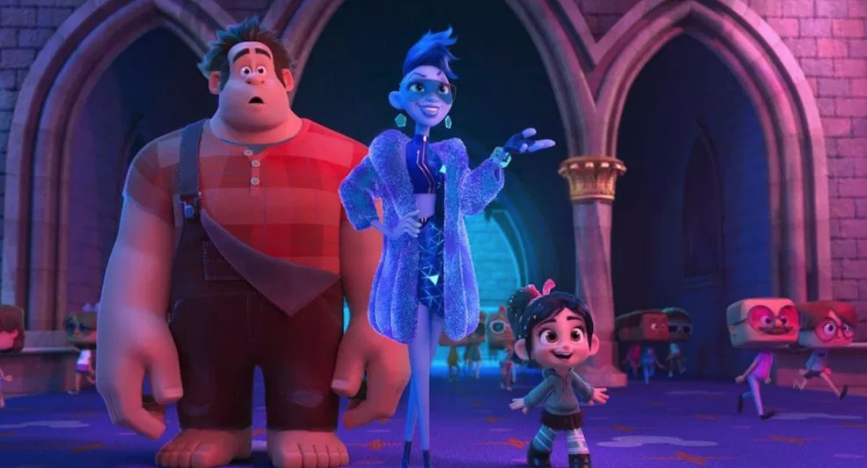Repair Work, by Reed Lackey
15 Nov
You’d expect a film with such a gimmicky title as Ralph Breaks the Internet to be little more than a sequence of pop culture sight gags and hopefully clever one-liners. You’d maybe expect an overwrought moral conclusion about the toxic dangers of how technology has irrevocably damaged our society. Perhaps you’d even expect a tidy little ending where our characters have all learned a valuable lesson but nothing has really changed very much.
What you probably wouldn’t expect – or at least I didn’t – is a strikingly thoughtful and often genuinely touching film about the both painful and hopeful nature of friendship and community. You certainly wouldn’t expect it to be one of the best sequels Disney has ever produced. I mean, come on… it’s called Ralph Breaks the Internet, for crying out loud.
The story begins with Wreck-It Ralph (John C. Reilly) and his best friend Vanellope (Sarah Silverman) living their everyday routine as two of the staple entries in Mr. Litwak’s Arcade, enjoying the evenings hanging out at Tapper’s and drinking root beer. Ralph is completely content to let this be their forever pattern, but Vanellope daydreams about something bigger and more exciting. When Ralph tries to help his dear friend out, he wrecks things (as usual) and possibly for good this time. But fortunately Mr. Litwak has recently installed Wifi into the arcade and our heroic pair believes that the World Wide Web is possibly the only place where they can fix what’s been broken.
My first of really very minimal complaints about this film is that the first twenty minutes feel alarmingly derivative and uninspired. There’s a chance that this was intentional, reflecting the stagnant routine in which Ralph and Vanellope have found themselves. But once the pair finally make their way onto the internet, the film immediately begins to soar and never lags again.
The vision of the internet through the internal lens established in Wreck-It Ralph is vibrant and energetic, teeming with observational references that’ll have home viewers freeze-framing every few seconds. It is all that you’d hope it could be in delivering humorous observations about internet culture without bogging down the narrative in too many contrivances or cheap gimmicks. Small moments like when they can’t take three steps without being accosted with a pop-up ad or the realization of a search engine as a physical character are genuinely charming and clever. But what’s surprising in the best way is how these clever jokes eventually become vital plot pivots and help push the narrative forward organically.
Visually, this film earns points for sheer variety. Avatars move and twitch differently than their character counterparts and the interior of the online competitive racing game, Slaughter Race, feels completely of itself in contrast to the internal headquarters of the social video site BuzzzTube. When Ralph and Vanellope finally make their inevitable way into Disney.com, it is some of the most gleefully enjoyable explorations the film makes. There is a sequence, hinted at in the trailers, wherein the plucky little Vanellope finds herself among nearly all of the classic Disney princesses. I say with no hyperbole whatsoever that this sequence is pure genius, hysterically crafted with a perfect blend of self-parody, cultural commentary, and pure, unfiltered fun. It also lays the groundwork for one of the film’s greatest payoffs in its final act and is worthy of applause.
What is perhaps most surprising – and most refreshing – about this film is how it actively resists cheapening its narrative by becoming overly preachy about patterns or behavior on the internet. While it is not remotely naïve about the frustrating and potentially negative consequences of our relationship with the internet, it does not make these elements its primary focus. Even a scene in which a character wanders into the “Comments Section” of a video they star in, witnessing painfully hurtful things being said about them, the moment is handled poignantly and sensitively before the narrative picks itself up and moves on, making the commentary more effective as a result.
The film also makes a rather bold and noteworthy choice to maintain genuine conflict and tension without ever introducing a primary villain. Conflicts and tensions arise from the relationships between the characters in ways that often prove insightful and are frequently touching. When a monster does finally make its inevitable appearance – resulting in some of the most genuinely unnerving visuals Disney has ever delivered – it is created by and must be dispelled by the choices of our principle characters, further enhancing the arcs in which they’re traveling and the lessons they are learning.
And ultimately those lessons are not about either how awesome or how dangerous the internet is, but rather how difficult it can sometimes be to navigate deeply cherished friendships when both people have dreams and goals which are drifting them in different directions. It manages to land in a remarkably mature and moving place without ever feeling tired or obvious. Despite the film’s understandably dated potential (how relevant will some of these references be ten years from now is anyone’s guess), this anchored exploration of friendship and community helps elevate Ralph Breaks the Internet above what could have easily been a sequence of amusing gimmicks into a funny, exciting, and heartfelt story worth seeing.
Featuring a talented supporting voice cast (including, most notably, Gal Gadot in her first voice-over role), sharp and clever writing, and a barrage of genuinely hysterical sequences, Ralph Breaks the Internet is an effectively entertaining and genuinely touching entry into Disney’s catalogue, and a must-see for any citizen of the digital revolution.
P.S. Please stay through the full end of the credits. There is a surprise at the end that gets my personal vote for greatest after-credits bonus ever. You won’t want to miss it.




No comments yet